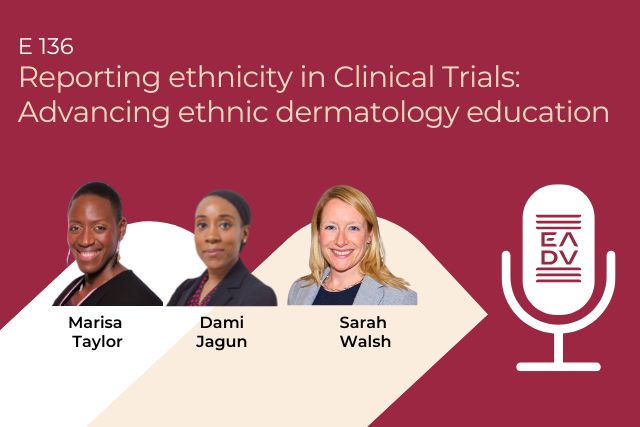Scientific Spotlights
The EADV Scientific Spotlights are a collection of expert insights and updates across various fields of dermatology and venereology.
Selected from our events, podcasts, and various academy activities, our Scientific Spotlights bring you the latest developments and in-depth discussions led by renowned specialists in dermatovenereology.


EADV Podcast ep. 141 – Editor’s Picks July 2025
Join Dr. Sarah Walsh presenting her selection of Editor’s Picks from the June 2025 issue:


European Guideline (EuroGuiDerm) on atopic eczema: Living update
A. Wollenberg et al.
JEADV Volume 39, Issue 5, May 2025


Hair disorders: Management
This session explores two challenging types of alopecia: androgenetic alopecia (AGA) and neutrophilic scarring alopecias, including dissecting cellulitis (DC) and folliculitis decalvans (FD). Experts will review the latest in diagnosis, pathophysiology, and personalized treatment strategies, ranging from established therapies to emerging options across pediatric and adult patients.


EADV Podcast ep. 140 – Advocacy in Action: EADV’s fight against Sunbed-related Skin Cancer
Dr. Tiago Matos and Prof. Myrto Trakatelli reflect on the recent EADV advocacy event at the European Parliament focused on the health risks of sunbed use.


Skin microbiome: its role in acne and hidradenitis suppurativa
In this presentation, we explore how skin microbiome dysbiosis contributes to acne and hidradenitis suppurativa (HS). Acne involves C. acnes phylotype IA1 dominance and S. epidermidis imbalance, while HS is linked to biofilm-related inflammation. We also highlight emerging microbiome-based therapies and personalized skincare approaches.


EADV Podcast ep. 139 – Editor’s Picks June 2025
Join Dr. Sarah Walsh presenting her selection of Editor’s Picks from the June 2025 issue:


EADV Podcast ep. 138 – Beyond the diagnosis: Prognostic Insights in Melanoma
Dr. Sarah Walsh, Dr. Marisa Taylor and Dr. Dami Jagun emphasise the need for better representation, specifically in Clinical Trials and improved training to ensure equitable care for all skin types.


Management of folliculitis decalvans: The EADV task force on hair diseases position statement
A. Waśkiel-Burnat et al.
JEADV Volume 39, Issue 4, April 2025


Nail disorders
This presentation reviews topical, intralesional, systemic, biologic and small molecules treatments, outlining indications based on the site and severity of nail involvement.


Genodermatoses
Skin, hair, and nails reveal systemic diseases. This session covers hair and nail signs in lupus, cancer, and cardiovascular issues. Hair loss patterns may indicate SLE or malignancies, while nail changes like clubbing or Beau’s lines signal systemic illness. Early recognition aids diagnosis and treatment. Another session focuses on nail dystrophy, stressing accurate diagnosis for effective care.


EADV Podcast ep. 137 – Editor’s Picks May 2025
Join Prof. Carle Paul presenting his selection of Editor’s Picks from the April 2025 issue:
(1) Medical progress in hidradenitis suppurativa: a time for hope
(2) Dermatological emergencies: do dermatologists still have a role to play?
(3) Curing scleromyxedema: plasma-cell directed therapy is the key
(4) Darier disease: a route towards disease understanding and targeted approach


EADV Podcast ep. 136 – Reporting ethnicity in Clinical Trials: Advancing ethnic dermatology education
Dr. Sarah Walsh, Dr. Marisa Taylor and Dr. Dami Jagun emphasise the need for better representation, specifically in Clinical Trials and improved training to ensure equitable care for all skin types.


Hair disorders: Management
This session explores two challenging types of alopecia: androgenetic alopecia (AGA) and neutrophilic scarring alopecias, including dissecting cellulitis (DC) and folliculitis decalvans (FD). Experts will review the latest in diagnosis, pathophysiology, and personalized treatment strategies, ranging from established therapies to emerging options across pediatric and adult patients.


Skin microbiome: its role in acne and hidradenitis suppurativa
In this presentation, we explore how skin microbiome dysbiosis contributes to acne and hidradenitis suppurativa (HS). Acne involves C. acnes phylotype IA1 dominance and S. epidermidis imbalance, while HS is linked to biofilm-related inflammation. We also highlight emerging microbiome-based therapies and personalized skincare approaches.


Nail disorders
This presentation reviews topical, intralesional, systemic, biologic and small molecules treatments, outlining indications based on the site and severity of nail involvement.


Genodermatoses
Skin, hair, and nails reveal systemic diseases. This session covers hair and nail signs in lupus, cancer, and cardiovascular issues. Hair loss patterns may indicate SLE or malignancies, while nail changes like clubbing or Beau’s lines signal systemic illness. Early recognition aids diagnosis and treatment. Another session focuses on nail dystrophy, stressing accurate diagnosis for effective care.


Hair and nail disorders
Skin, hair, and nails reveal systemic diseases. This session covers hair and nail signs in lupus, cancer, and cardiovascular issues. Hair loss patterns may indicate SLE or malignancies, while nail changes like clubbing or Beau’s lines signal systemic illness. Early recognition aids diagnosis and treatment. Another session focuses on nail dystrophy, stressing accurate diagnosis for effective care.


Unveiling the Pathomechanism of Behçet’s Disease
EADV funded
Behçet’s disease (BD) is a chronic, relapsing multisystemic vasculitis that typically affects individuals in their 30s and 40s, leading to significant morbidity. Its pathogenesis remains enigmatic, shaped by complex genetic, environmental, autoimmune, and autoinflammatory factors.


Skin and sexually transmitted infections and health promotion strategy in migrant populations in Malta and Lebanon
EADV funded
The SSKAPP project promotes skin disease and STI education among migrants in Malta and Lebanon, using teledermatology and outreach clinics. It served over 3,200 migrants in Malta and diagnosed 598 cases in Lebanon, while training healthcare providers and supporting refugee care.


Tumour-specific antibodies able to detect melanoma in its earliest stages, new study shows
EADV Press Release
Innovative research has unveiled promising advancements in melanoma detection, which could significantly enhance diagnosis and prognosis by identifying the disease at its earliest, most treatable stages.


New research confirms link between perceived stress and psoriasis relapse
EADV Press Release
Innovative research has provided compelling evidence that perceived stress can directly trigger the relapse of psoriatic skin lesions.


Breakthrough research identifies new targets for wound healing
EADV Press Release
Novel research has identified key molecular targets that could significantly enhance the healing of both acute and chronic wounds.


Semaglutide improves outcomes for obese patients with common skin condition, new study shows
EADV Press Release
A pioneering study demonstrates the significant potential of semaglutide in treating hidradenitis suppurative (HS), a common and chronic skin condition, in people with obesity.


Use of mohs surgery in non-keratinocytic tumours
Mohs micrographic surgery (MMS) is the gold standard for basal and squamous cell carcinomas and is increasingly used for non-keratinocytic tumors, including melanomas like lentigo maligna melanoma (LMM) and melanoma in situ (MIS). MMS offers precise cancer removal, but its use for deeper melanomas is still controversial and requires more research.


EADV Podcast ep. 141 – Editor’s Picks July 2025
Join Dr. Sarah Walsh presenting her selection of Editor’s Picks from the June 2025 issue:


EADV Podcast ep. 140 – Advocacy in Action: EADV’s fight against Sunbed-related Skin Cancer
Dr. Tiago Matos and Prof. Myrto Trakatelli reflect on the recent EADV advocacy event at the European Parliament focused on the health risks of sunbed use.


EADV Podcast ep. 139 – Editor’s Picks June 2025
Join Dr. Sarah Walsh presenting her selection of Editor’s Picks from the June 2025 issue:


EADV Podcast ep. 138 – Beyond the diagnosis: Prognostic Insights in Melanoma
Dr. Sarah Walsh, Dr. Marisa Taylor and Dr. Dami Jagun emphasise the need for better representation, specifically in Clinical Trials and improved training to ensure equitable care for all skin types.


EADV Podcast ep. 137 – Editor’s Picks May 2025
Join Prof. Carle Paul presenting his selection of Editor’s Picks from the April 2025 issue:
(1) Medical progress in hidradenitis suppurativa: a time for hope
(2) Dermatological emergencies: do dermatologists still have a role to play?
(3) Curing scleromyxedema: plasma-cell directed therapy is the key
(4)


EADV Podcast ep. 136 – Reporting ethnicity in Clinical Trials: Advancing ethnic dermatology education
Dr. Sarah Walsh, Dr. Marisa Taylor and Dr. Dami Jagun emphasise the need for better representation, specifically in Clinical Trials and improved training to ensure equitable care for all skin types.


EADV Podcast ep. 135 – Editor’s Picks April 2025
Join Prof. Carle Paul presenting his Editor’s Picks of March 2025:
(1) Happiness and inflammatory skin diseases: a European perspective
(2) Handheld reflectance confocal microscopy to guide surgical intervention in lentigo maligna
(3) Self-stigma and skin disease
(4) Banning samples from dermatology conferences?


EADV Podcast ep. 134 – Bullying and psychological burden of skin conditions in young patients: A conversation with Dr. Tess McPherson
Skin conditions can visibly affect young patients, but their psychological impact often goes unnoticed.
Join Dr. Sarah Walsh and Dr. Tess McPherson, past President of the British Society for Paediatric and Adolescent Dermatology, as they explore the psychological challenges associated with skin conditions.


EADV Podcast ep. 133 – Editor’s Picks March 2025
Join Prof. Carle Paul presenting his Editor’s Picks of March 2025:
(1) Happiness and inflammatory skin diseases: a European perspective
(2) Handheld reflectance confocal microscopy to guide surgical intervention in lentigo maligna
(3) Self-stigma and skin disease
(4) Banning samples from dermatology conferences?


EADV Podcast ep. 132 – Trichophyton mentagrophytes ITS genotype VII Outbreak in Europe
Join Prof. Carle Paul, Editor-in-Chief of JEADV, and a leading mycologist, Arnaud Jabet, Assistant Professor at the Pitié-Salpêtrière University Hospital in Paris, first author of an important paper published in the February issue of JEADV.


EADV Podcast ep. 131 – Editor’s Picks February 2025
Join Dr. Christian Posch, JEADV Associate Editor, presenting his selection of Editor’s Picks from the February 2025 issue:
(1) Navigating healthcare with atopic dermatitis: analysing patient journeys in Germany
(2) Characterization of patients with atopic dermatitis based on flare patterns and severity of disease: a Danish population-based study<br


EADV Podcast ep. 130 – Dermatology insights with EADV President Branka Marinovic
Dr. Sarah Walsh sits down with Prof. Branka Marinović, the newly appointed President of the European Academy of Dermatology and Venereology.
Prof. Marinović shares her remarkable journey in dermatology, her vision for advancing dermatology education and her advice for young professionals.
Recently uploaded EADV Guidelines


European Guideline (EuroGuiDerm) on atopic eczema: Living update
A. Wollenberg et al.
JEADV Volume 39, Issue 5, May 2025


Management of folliculitis decalvans: The EADV task force on hair diseases position statement
A. Waśkiel-Burnat et al.
JEADV Volume 39, Issue 4, April 2025


EuroGuiderm guideline on lichen sclerosus – Treatment of lichen sclerosus
G. Kirtschig et al.
JEADV Volume 38, Issue 10, October 2024,
Pages 1874-1909


EuroGuiderm guideline on lichen sclerosus – introduction into lichen sclerosus
G. Kirtschig et al.
JEADV Volume 38, Issue 10, October 2024,
Pages 1850-1873


European consensus-based interdisciplinary guideline for diagnosis, treatment and prevention of actinic keratoses, epithelial UV-induced dysplasia and field cancerization
Lidija Kandolf et al.
JEADV Volume 38, Issue 6, June 2024,
Pages 1024-1047


S2k guidelines on diagnosis and treatment of linear IgA dermatosis initiated by the European Academy of Dermatology and Venereology
Frédéric Caux, Aikaterini Patsatsi et al.
JEADV Volume 38, Issue 6, June 2024,
Pages 1006-1023
Recently uploaded EADV Position Statements


Alert on a false health claim: There are no authorised cerebral effects of cosmetics
Press Release from EADV’s Psychodermatology Task Force
Some cosmetic providers claim that the application of their cosmetic products to the skin can have direct effects on the nervous system and brain.
Read the full position statement


Position statement on latest study regarding benzene in Acne products
Press Release from EADV’s Acne, Rosacea and Hidradenitis Suppurativa Task Force
Benzene, a highly volatile chemical, poses significant health risks, classified as a Group 1 carcinogen by IARC. Exposure occurs through various sources, including industrial emissions, tobacco smoke, and contaminated cosmetics. Recent findings of benzene in anti-acne products raise concerns,



